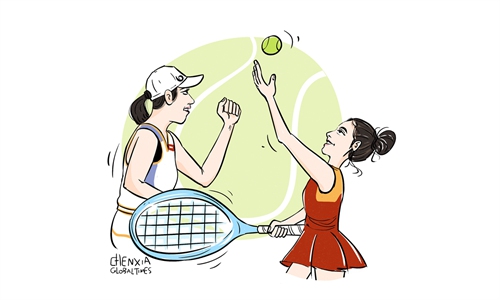ARTS / CULTURE & LEISURE
Nationwide tennis participants over 25m by Aug 2024: report
On-court achievements spark public enthusiasm

Zheng Qinwen of China celebrates during the Miami Open tennis tournament, on March 24, 2025, in Miami. Photo: VCG
The number of tennis participants in China had exceeded 25 million as of August 31, 2024, a nearly 30 percent increase compared to 2021, said a report about the country's tennis industry development released by the Tennis Administrative Center of General Administration of Sport of China on Wednesday.This is the first time that China has released basic data on the development of its tennis industry, covering figures related to the tennis population, tennis courts, training institutions, athletes, coaches, stringers, fitness trainers, rehabilitation specialists, and manufacturers of tennis-related equipment.
Observers noted that the achievements Chinese tennis athletes have made in recent years have sparked public enthusiasm for the sport, leading to a significant increase in the number of participants. However, compared to the large number of tennis enthusiasts, both the equipment such as tennis courts, and professional support, such as coaches, fitness trainers and stringers, still needed to be improved in both quantity and quality.
According to the report, there were 25,188,388 people participating in tennis as of August 31, 2024, a growth rate of 28.03 percent compared to the number reported by the International Tennis Federation (ITF) in 2021.
The proportion of female participation in tennis has also increased. While 55 percent of China's tennis population were male and 45 percent were female according to the 2021 ITF report, the latest 2024 survey shows that 53 percent of the population were male and 47 percent were female.
The top 10 provinces and province-level municipalities in terms of tennis population are South China's Guangdong, Southwest China's Sichuan, Central China's Hubei, Beijing, East China's Zhejiang, Central China's Henan, East China's Jiangsu, Shanghai, North China's Inner Mongolia Autonomous Region and East China's Anhui.
According to the report, the number of tennis courts across the country has grown to 53,805 from the 49,767 estimated by ITF in 2021, a growth rate of 8.12 percent.
With regard to tennis athletes, there are 6,313 registered players with the General Administration of Sport. While the number of registered teenage athletes among these 6,313 players reached 5,402, it is estimated that there were about 506,000 youth players who haven't registered but participated in tennis competitions at different levels.
The report comes amid the higher attention Chinese people are paying to the sport as Chinese tennis players such as Zheng Qinwen, Wang Xinyu and Zhang Zhizheng have seen rapid improvements in international rankings, recognition, and performance, Chen Chi, a Beijing-based tennis commentator, told the Global Times.
Zheng made a name for herself in 2024, highlighted by her Olympic gold in Paris and runner-up finish at the Australian Open. At the Paris 2024 Olympic Games, Zhang and Wang also made a historic breakthrough for China by taking a silver medal in the mixed doubles.
In 2025, the Australian Open in January witnessed a record 11 Chinese players participate in the main draw. The main draw entry list for the upcoming French Open in May includes four Chinese players: Zheng Qinwen, Wang Xinyu, Zhang Zhizhen, and Bu Yunchaokete.
After Zheng won the gold medal at the Paris Olympics, tennis - once seen as an elite and niche sport - has been gradually transforming into a sport embraced by the general public, Chen said, adding that grassroots-level tournaments, which were not included in the report, actually play an important role in boosting Chinese people's participation.
Ni Wei, secretary-general of the Beijing Tennis Association, said that, besides thriving grassroots-level tennis tournaments, the number of tennis coaches, referees, event organizers and training institutions has also been gradually expanding in recent years, further strengthening the grassroots foundation of tennis, the Economic Daily reported.
According to a 2024 report released by the Tennis Administrative Center, there are about 1,668 tennis stringers, 4,110 tennis fitness trainers, and 4,758 tennis rehabilitation specialists in China. There are 197 Chinese companies engaged in original equipment manufacturing production for the international tennis industry, mainly concentrated in the provinces of Guangdong and Zhejiang, while there are 437 companies independently producing tennis-related equipment and facilities for the domestic market, mostly located in the Zhejiang, Jiangsu, Guangdong, Fujian, and Jiangxi provinces.
The report shows that China's tennis population has grown significantly, and the number of tennis courts has increased, but it still falls short of meeting the needs of such a large group of participants, said Li Na, head coach of the tennis team at Beijing Foreign Studies University (BFSU).
A former professional player for Central China's Hunan provincial team who has been teaching tennis and coaching the university team at BFSU since 1998, Li told the Global Times that resources such as coaches, fitness trainers, stringers, and training institutions also remain insufficient.
"Looking ahead, improvements in both the quantity and quality of these supporting facilities are needed. Driven by players like China's tennis ace Zheng Qinwen, the future of tennis in China looks promising, but stronger 'hardware' and 'software support' are essential," Li added.
Chen said that to boost the sport's future development, it will be essential to improve youth training systems, talent development pathways, and the structure of competitions - including how grassroots tournaments can be gradually improved and well-organized.



